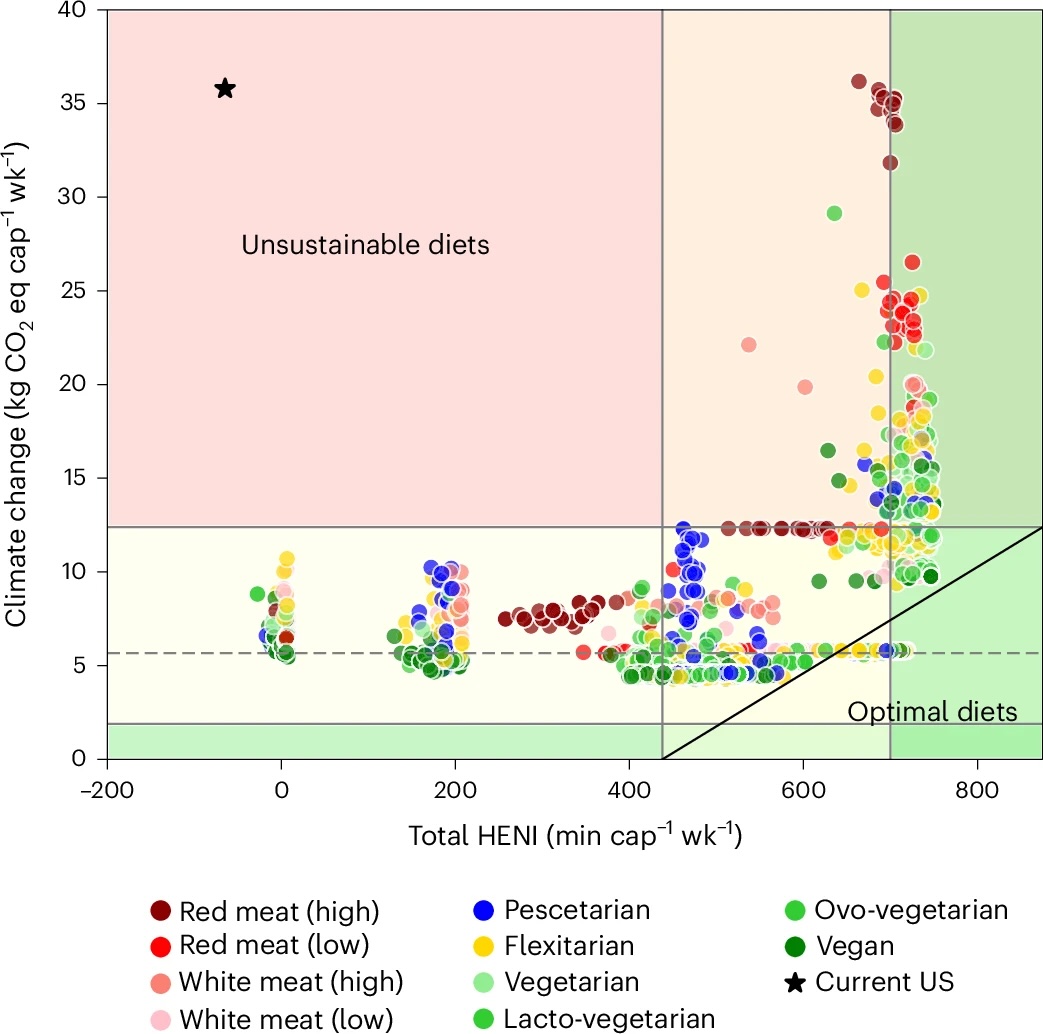Sustainable Eating: How Much Meat Can You Eat?
By Archyde News Staff
Reconciling personal dietary needs with environmental duty can feel like a constant struggle.Many people are seeking a sustainable path that balances their health with the planet’s well-being. Now, a team of environmental scientists at the Technical University of Denmark offers some concrete guidance, pinpointing a sustainable amount of meat consumption that can inform our grocery shopping.
The “Sweet Spot” for Meat Consumption
Caroline Gebara, lead author of the study and an environmental scientist, notes, “Most people now realize that we should eat less meat for both environmental and health reasons. But it’s hard to relate to how much ‘less’ is and whether it really makes a difference in the big picture.”
The team’s research, published in nature Food, suggests a weekly limit of 255 grams (approximately 9 ounces) of poultry or pork. This equates to roughly two chicken breasts,a far cry from the average meat consumption in the U.S. and Europe.
Red Meat’s Impact
The study indicates that red meat, notably beef, poses a significant challenge to environmental sustainability. The resource-intensive nature of raising cattle and sheep,including land clearing and greenhouse gas emissions,contributes heavily to its impact. these animals release methane,a greenhouse gas with a global warming potential 28 times higher than carbon dioxide,as well as nitrous oxide,which is 270 times more potent.
| Food Source | Kilograms of CO2 equivalents per kilogram of food |
|---|---|
| beef | 27 |
| Lamb | 23 |
| Pork | 12 |
| Poultry | 6 |
Gebara emphasizes, “Our calculations show that even moderate amounts of red meat in one’s diet are incompatible with what the planet can regenerate of resources based on the environmental factors we looked at in the study.” However, she adds, “There are many other diets – including ones with meat – that are both healthy and sustainable.”
Historical Perspective and Current Trends
Humans have consumed meat for millions of years, but the current level of consumption is unsustainable. animal agriculture leaves a substantial environmental footprint due to greenhouse gas emissions, land degradation, and the energy required for transportation and processing.
A 2018 study published in *Science* found that even the lowest-impact animal products cause more environmental harm than the least sustainable plant-based options. Furthermore,a 2023 report by the UN Environment Program calls for a shift towards more plant-rich diets to reduce the impact of food production on the environment.
Methodology and Findings
The Danish team conducted extensive literature reviews to establish constraints for both healthy diets (meeting 32 key nutritional requirements) and environmentally sustainable diets (based on planetary sustainability thresholds).This data was used to create a model that calculates the appropriate weekly intake of various foods to minimize environmental strain.
The model factored in several key environmental indicators, including:
- Greenhouse gas emissions
- Land use
- Water use
- Nitrogen and phosphorus pollution

The research suggests that incorporating cheese, eggs, fish, and white meat into a diet can be sustainable if balanced with healthy and environmentally conscious choices. Gebara says, “For example, our calculations show that it’s possible to eat cheese if that is critically importent to you, while simultaneously occurring having a healthy and climate-friendly diet. The same is true for eggs, fish, and white meat, but the premise is of course that the rest of your diet is then relatively healthy and sustainable. But it doesn’t have to be either-or.”
Limitations and Considerations
The authors acknowledge the limitations of their model, including potential oversimplification of individual dietary needs and reliance on U.S. food characteristics, which may not be globally representative. The model also assumes consistent environmental impacts of food production, which may vary due to technological advancements and changing agricultural practices.
In addition, the study does not fully account for accessibility, affordability, and cultural acceptance, which are crucial factors in achieving truly sustainable diets. the authors write, “Our study focused on the biophysical limits of human nutrient intake and environmental impacts, but overlooked other aspects such as accessibility, affordability, and cultural acceptance. Achieving truly sustainable diets requires worldwide availability, which must be supported by policymakers at all levels.”
Ultimately, policymakers at all levels must act to support the availability of sustainable diets.
What strategies do you employ for meat consumption in your own household?
Sustainable Eating and Meat Consumption: An Archyde News Interview
Archyde News: Welcome, everyone, to Archyde News.Today, we have Dr. Anya Sharma, a leading nutritionist and sustainability expert, to discuss the critical question of sustainable eating, and more specifically, how much meat we can consume while being environmentally responsible. Dr. Sharma, welcome to the show.
Dr. Sharma: Thank you for having me. It’s a crucial topic that deserves attention.
Archyde News: Absolutely. Recent studies have emphasized the environmental impact of meat consumption. Can you shed some light on what the current research suggests regarding a sustainable level of meat intake?
Dr. Sharma: Certainly. research, including studies from the Technical university of Denmark, suggests that drastically reducing meat consumption is key. The study pinpointed a weekly limit of about 255 grams – or about 9 ounces – of poultry or pork as a target for sustainability. That’s roughly two chicken breasts. For red meat, the advice is even lower, and we should understand that the amount of consumption must be drastically reduced.
Archyde News: That’s quite a shift from average consumption levels in many regions. Considering the varying impacts of different meats, could you elaborate on why red meat, such as beef and lamb, poses a greater challenge to environmental sustainability?
Dr. Sharma: The primary reason is the intensive resources required to raise cattle and sheep. This includes significant land use,deforestation for grazing,and the high emission of greenhouse gases,especially methane,which has a potent global warming effect. Studies show that beef has an environmental impact that is several-fold higher compared to poultry or pork.
Archyde News: The analysis from the study goes beyond just meat, doesn’t it? how does this fit into a broader approach, and how does the research incorporate other food groups, like cheese, eggs and fish?
Dr. Sharma: Yes, the research explores how all these things impact the habitat, by considering things such as carbon emissions, water use, land use, and pollution. The findings suggest that you can eat eggs, fish, cheese, and white meat as part of a healthy and climate-pleasant dietary plan if you balance the rest of the foods in your diet. It’s about creating that balance. But it doesn’t have to be all or nothing.
Archyde News: It’s easy to see a shift coming and to find it tough to adopt. what are some of the key takeaways from the research in terms of encouraging a shift towards reducing meat consumption, from your outlook?
Dr. Sharma: The key here is that people can still incorporate meat into their diets. It just may require adjusting the proportion in our diet. But, the scientific advice is clear. We must consider shifting the way that we approach our food plans, and we must encourage and support sustainable diets on a global scale.
Archyde news: The study mentions the importance of accessibility, affordability, and cultural acceptance. How critical are these factors in achieving truly sustainable diets?
Dr. Sharma: They are crucial. A sustainable diet isn’t just about the science of what’s best for the environment. It’s also about making those healthy and sustainable options accessible, affordable, and culturally appropriate for people worldwide. Policymakers have a significant role to play in supporting these elements. They must provide the framework to make healthy choices available worldwide.
Archyde News: Dr. Sharma, this has been incredibly insightful. One final thought: What,in your opinion,is the most significant thing individuals can do right now to integrate a sustainable approach to meat consumption into their diets?
Dr. Sharma: Start by being well-informed. Understand the impact of your choices. Then, consider gradually reducing your meat consumption, while also prioritizing the sourcing of your meat. Consider where it comes from, how it was raised, and what practices where employed. Also, diversify your diet to include more plant-based meals. Every step counts. What are some of the strategies you employ for meat consumption in your own household? please share your ideas in the comments.
archyde News: Thank you, dr. Sharma, for your expert insights. It’s clear that sustainable eating requires a conscious effort from both individuals and policymakers.We hope this conversation has given our audience valuable food-related guidance. Thank you everyone for joining us.







